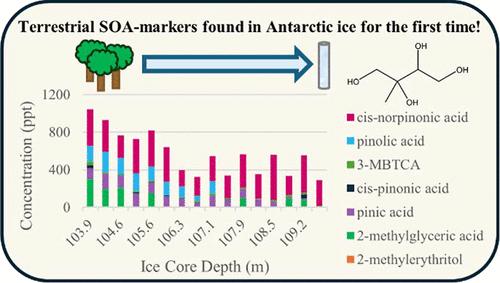当前位置:
X-MOL 学术
›
Environ. Sci. Technol.
›
论文详情
Our official English website, www.x-mol.net, welcomes your
feedback! (Note: you will need to create a separate account there.)
Novel Method to Quantify Trace Amounts of Isoprene and Monoterpene Secondary Organic Aerosol-Markers in Antarctic Ice
Environmental Science & Technology ( IF 10.8 ) Pub Date : 2024-11-18 , DOI: 10.1021/acs.est.4c09985 Emilia E. Bushrod, Elizabeth R. Thomas, Alexander Zherebker, Chiara Giorio
Environmental Science & Technology ( IF 10.8 ) Pub Date : 2024-11-18 , DOI: 10.1021/acs.est.4c09985 Emilia E. Bushrod, Elizabeth R. Thomas, Alexander Zherebker, Chiara Giorio

|
Biogenic volatile organic compounds (BVOCs) contribute to the formation of secondary organic aerosol (SOA) through atmospheric oxidation. Previously detected SOA-markers in northern hemisphere ice cores from Alaska, Greenland, Russia, and Switzerland indicate the transportation of isoprene and monoterpene oxidation products from their forestry sources to these glacial regions. Antarctica is geographically further removed from the BVOC’s source, indicating significantly lower SOA-marker concentrations are likely in southern hemisphere ice cores. The aim of this study was to develop a sensitive mass-spectrometric method to detect and quantify low-abundance SOA-markers of isoprene and monoterpenes in ice core samples. Employment of a triple quadrupole HPLC–MS method enabled limit of detections in the range of 0.4–10 ppt for nine terrestrial SOA-markers and a marker of biomass burning, levoglucosan. Quantification was conducted in the multiple reaction monitoring mode with two specific transitions monitored for each target compound. Application of the developed method onto a section of a Jurassic ice core from Antarctica revealed the presence of seven of the target compounds: 2-methylerythritol, 2-methylglyceric acid, cis-pinonic acid, 3-methyl-1,2,3-butanetricarboxylic acid, pinolic acid, cis-norpinonic acid, and pinic acid. Repeatability ranged between 2.2% and 6.2%. This is the first time that such SOA-markers have been discovered and quantified in Antarctic ice.
中文翻译:

定量南极冰中痕量异戊二烯和单萜次级有机气溶胶标志物的新方法
生物挥发性有机化合物 (BVOC) 有助于通过大气氧化形成二次有机气溶胶 (SOA)。先前在阿拉斯加、格陵兰岛、俄罗斯和瑞士的北半球冰芯中检测到的 SOA 标志物表明异戊二烯和单萜氧化产物从其林业来源运输到这些冰川地区。南极洲在地理上与 BVOC 的来源相距甚远,这表明南半球冰芯中的 SOA 标志物浓度可能显着降低。本研究的目的是开发一种灵敏的质谱方法来检测和定量冰芯样品中异戊二烯和单萜的低丰度 SOA 标志物。采用三重四极杆 HPLC-MS 方法使 9 种陆地 SOA 标志物和一种生物质燃烧标志物左旋葡萄糖聚糖的检测限保持在 0.4-10 ppt 的范围内。在多反应监测模式下进行定量,监测每种目标化合物的两个特异性离子对。将开发的方法应用于来自南极洲的侏罗纪冰芯的一部分,揭示了七种目标化合物的存在:2-甲基赤藓糖醇、2-甲基甘油酸、顺式-松酸、3-甲基-1,2,3-丁烷三羧酸、松醇酸、顺式-去甲松酸和松酸。重复性范围在 2.2% 至 6.2% 之间。这是首次在南极冰层中发现和量化此类 SOA 标志物。
更新日期:2024-11-19
中文翻译:

定量南极冰中痕量异戊二烯和单萜次级有机气溶胶标志物的新方法
生物挥发性有机化合物 (BVOC) 有助于通过大气氧化形成二次有机气溶胶 (SOA)。先前在阿拉斯加、格陵兰岛、俄罗斯和瑞士的北半球冰芯中检测到的 SOA 标志物表明异戊二烯和单萜氧化产物从其林业来源运输到这些冰川地区。南极洲在地理上与 BVOC 的来源相距甚远,这表明南半球冰芯中的 SOA 标志物浓度可能显着降低。本研究的目的是开发一种灵敏的质谱方法来检测和定量冰芯样品中异戊二烯和单萜的低丰度 SOA 标志物。采用三重四极杆 HPLC-MS 方法使 9 种陆地 SOA 标志物和一种生物质燃烧标志物左旋葡萄糖聚糖的检测限保持在 0.4-10 ppt 的范围内。在多反应监测模式下进行定量,监测每种目标化合物的两个特异性离子对。将开发的方法应用于来自南极洲的侏罗纪冰芯的一部分,揭示了七种目标化合物的存在:2-甲基赤藓糖醇、2-甲基甘油酸、顺式-松酸、3-甲基-1,2,3-丁烷三羧酸、松醇酸、顺式-去甲松酸和松酸。重复性范围在 2.2% 至 6.2% 之间。这是首次在南极冰层中发现和量化此类 SOA 标志物。


















































 京公网安备 11010802027423号
京公网安备 11010802027423号